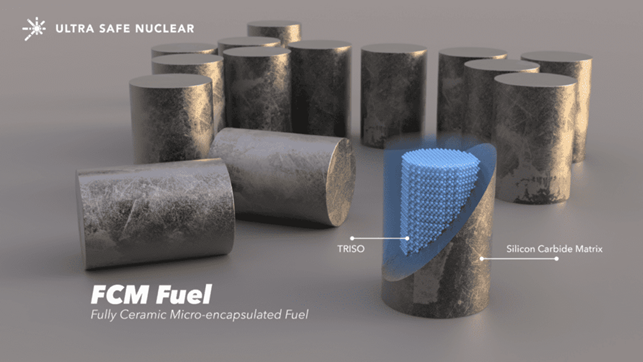Artist’s rendering of Kairos Power’s KP-FHR reactor. (Image: Kairos Power)
The Tennessee Valley Authority and nuclear technology and engineering company Kairos Power this morning announced plans to collaborate on the deployment of the latter’s low-power demonstration reactor, dubbed Hermes, at the East Tennessee Technology Park (ETTP) in Oak Ridge, Tenn. TVA will provide engineering, operations, and licensing support to help Kairos with deployment, according to the announcement.
The Surry nuclear power plant, near Surry, Va. Photo: Dominion Energy
The Nuclear Regulatory Commission has approved Dominion Energy’s application to renew the Surry nuclear power plant’s operating licenses for an additional 20 years. The renewed licenses authorize the extension of reactor operation at the two-unit plant from 60 to 80 years.
Indian Point-3’s turbine hall and generator. Photo: Entergy
The disturbingly long list of U.S. nuclear plants prematurely closed in recent years will get even longer tonight when the last reactor at the Indian Point Energy Center, Unit 3, powers down for the final time. The shutdown, scheduled for 11 p.m. local time, will mark the end of nearly 60 years of zero-carbon electricity generation at the Buchanan, N.Y., facility.
Two of the state’s six nuclear plants nearly closed in 2016, but legislative action saved them. Now two more are at risk.
If there is one U.S. state you might think would be on top of the nuclear-plant-retirement problem, it’s Illinois: With 11 power reactors, more than any other state, it is number one in nuclear generating capacity. In 2019, 54 percent of its in-state generation came from nuclear power. So why, at this writing in mid-April, does Illinois still face the possibility of losing two of its nuclear plants later this year?
The Hope Creek nuclear power plant. Photo: Peretzp
New Jersey’s Board of Public Utilities (BPU) yesterday voted unanimously to extend, for an additional three years, the zero emission certificate (ZEC) program benefitting the state’s two operating nuclear power plants, Hope Creek and Salem. The two facilities produce more than 90 percent of New Jersey’s carbon-free electricity and about 40 percent of its overall power.
The CB-20 module is placed atop the Vogtle-4 containment vessel. Photo: Georgia Power
Georgia Power yesterday announced two significant milestones at the Vogtle nuclear plant’s expansion project: the commencement of hot functional testing at Unit 3 and the placement of Unit 4’s passive containment cooling water storage tank, known as CB-20.
Watts Bar nuclear power plant in Tennessee
Construction and maintenance services firm Day & Zimmermann (D&Z) has paid $200,000 to resolve allegations that it submitted false claims to the Tennessee Valley Authority for services performed in connection with capital improvement projects at the Watts Bar nuclear plant, the U.S. Attorney’s Office for the Eastern District of Tennessee announced last week.
Artist’s view of heavy water eliciting sweet taste in humans. Graphic design: Tomáš Bello/IOCB Prague
Is isotope science all sweetness and light? Recent headlines on research confirming the sweet taste of heavy water and the creation of the lightest isotope of uranium yet may give that impression. But the serious science behind these separate research findings has implications for human health and for the understanding of the process of alpha decay.
Salem Nuclear Power Plant as photographed from Delaware Bay.
When a nuclear power plant closes, here is what happens:
Thousands of people lose their jobs. The local economy nosedives. Air pollution increases. Reliance on natural gas, often bought from out-of-state, goes up. Electricity on the grid becomes less reliable with the loss of the most reliable source of power. And electric prices can even rise.
Fully ceramic microencapsulated fuel. Image: USNC
Canadian Nuclear Laboratories (CNL) announced last week that it has fabricated fully ceramic microencapsulated (FCM) fuel pellets, a proprietary reactor fuel designed by Ultra Safe Nuclear Corporation (USNC) for its Micro Modular Reactor (MMR). The FCM project, funded through the Canadian Nuclear Research Initiative (CNRI), represents the first time that tristructural isotropic (TRISO) fuel has been manufactured in Canada, according to CNL.
Alberta Premier Jason Kenney at an online event on April 14, after signing an agreement on small modular reactor development. Photo: Chris Schwarz/Government of Alberta
Alberta Premier Jason Kenney has added his signature to a memorandum of understanding on small modular reactor development that was signed in 2019 by the premiers of New Brunswick, Ontario, and Saskatchewan. Kenney signed the document last week at a virtual event that also promoted the release of Feasibility of Small Modular Reactor Development and Deployment in Canada—a study formally requested as part of the MOU.





 Peter Lyons, former Nuclear Regulatory Commission commissioner (2005–2009) and assistant secretary of energy for nuclear energy (2011–2015), has passed away.
Peter Lyons, former Nuclear Regulatory Commission commissioner (2005–2009) and assistant secretary of energy for nuclear energy (2011–2015), has passed away.




 The decline in global carbon dioxide emissions recorded last year will not continue through 2021, a new report from the International Energy Agency concludes. Released last week,
The decline in global carbon dioxide emissions recorded last year will not continue through 2021, a new report from the International Energy Agency concludes. Released last week, 





